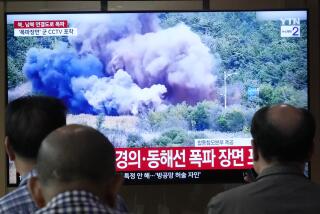Coastal Resort Brings Hard Currency to North Korea
- Share via
ONJUNG-RI, North Korea — From his perch on a huge illuminated billboard, the founder of this communist state, Kim Il Sung, smiles down benevolently as, a few yards away, North Korean waitresses serve beer and snacks to a crowd of cheerfully tipsy South Korean tourists.
Behind a booth at the outdoor cafe, a decidedly sober-looking North Korean manager with a Kim Il Sung button on the lapel of her tweed jacket methodically counts a fat wad of U.S. dollars.
Through ventures such as this at Onjung-ri, the main tourist center of the Mt. Kumgang enclave on North Korea’s southeastern coast, the regime is trying to meld Kim Il Sung’s anti-capitalist ideology with its desperate need for money.
“They hate the United States, but they love U.S. dollars,” said Oh Mi Seon, a South Korean executive who works at one of the resort’s hotels.
Since it opened in 1998, the Mt. Kumgang tourist operation has provided the regime of Kim Jong Il, the founder’s son, with at least $490 million, becoming one of North Korea’s largest legal sources of hard currency, say Western diplomats who have analyzed the country’s finances.
Despite the long-simmering tensions over North Korea’s nuclear weapons program, the tourist business is better than ever. Last year 260,000 tourists, mostly South Koreans, visited Mt. Kumgang, more than triple the previous year, and the number is expected to grow 40% this year, according to Hyundai Asan, the South Korean company that operates the resort.
Hyundai Asan hopes to open two new tourist enclaves in the North this year. Last month Kim met with the company’s chairwoman in Pyongyang, North Korea’s capital, to sign off on a deal to bring tourists to Kaesong, a historic city just north of the demilitarized zone, and to Mt. Paektu, a famous peak on the China-North Korea border. Pilot tours are expected to take place this month. “Everything is happening right now. There is a very positive atmosphere for dialogue and for new tour opportunities,” Jang Whan Bin, a director of Hyundai Asan, said last month. From the look of things at Mt. Kumgang, the North Korean government is eager to do business as long as it has a tight rein on the purse strings.
The cafe, for example -- a Korean version of a beer garden -- has a spontaneous and casual look to it, but it is in fact owned by an agency called the People’s General Service Bureau.
Two years ago, most of the facilities in the enclave were South Korean-owned and most of the employees Chinese or Philippine. Today North Koreans are running and staffing five restaurants with attractive women well trained to smile politely at the South Korean tourists.
“We’re very glad to see and serve our own people here,” said Kim Eun Ok, a 20-year-old North Korean waitress serving coffee in the chandeliered lobby of Mt. Kumgang Hotel.
Even the portable toilets along the hiking trails come with a hefty price tag: Tourists are advised that they should pay $1 if they urinate, $2 if they defecate, although -- despite the North Korean regime’s reputation as “big brother” -- nobody seems to inspect. (“It’s up to your conscience to pay what you owe,” said tour guide Cho Ara.)
Hyundai Asan officials say North Koreans have become far more comfortable with tourists in recent years. When the tours started in the late 1990s, there was hardly any contact between North and South Koreans, and the tourists were given a long list of rules. No jeans were permitted, no Bibles, no T-shirts with slogans in English.
“Nowadays it is much more relaxed. We don’t have so many problems,” said Kim In Chol, a South Korean who manages Mt. Kumgang Hotel. “The North Korean mind-set is changing. They are slowly opening their minds.”
Today the enclave is abuzz with construction activity. The highlights include an 18-hole golf course and a beach hotel. Although tourists now travel in buses across the DMZ, plans are underway to permit South Koreans to drive their own cars.
The boom marks a stunning turnaround for the Mt. Kumgang project, which nearly closed two years ago amid the international turmoil over North Korea’s nuclear weapons program and a political scandal in South Korea. In 2003, Hyundai Asan Chairman Chung Mong Hun leaped to his death from the company’s high-rise headquarters in Seoul just days after he was questioned by prosecutors over alleged bribes paid to North Korea.
Hyundai officials are aware that if the six-party talks underway in Beijing over the North’s nuclear program end in failure, there could be pressure from the Bush administration and from South Korean conservatives to stem the flow of tourist dollars across the border.
For their part, the North Koreans appear to view the success of Mt. Kumgang as a gesture of defiance against the U.S.
In June, when Hyundai Asan celebrated the visit of the millionth tourist to the enclave, North Korea’s official Korean Central News Agency declared it a “a victory of the patriotic forces for reunification over the traitorous forces for division” -- a reference to the U.S.
This is the kind of talk that makes Hyundai Asan nervous.
“We want to separate ourselves from political and military issues,” director Jang said. “We see what we are doing as a pure economic development project. But it is difficult.”
More to Read
Sign up for The Wild
We’ll help you find the best places to hike, bike and run, as well as the perfect silent spots for meditation and yoga.
You may occasionally receive promotional content from the Los Angeles Times.






